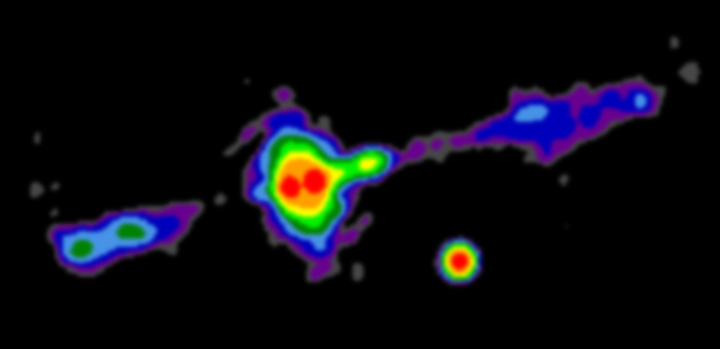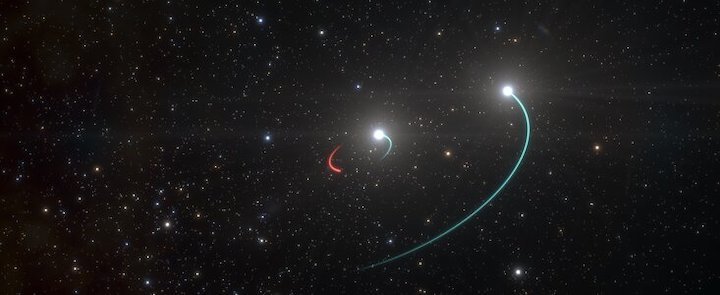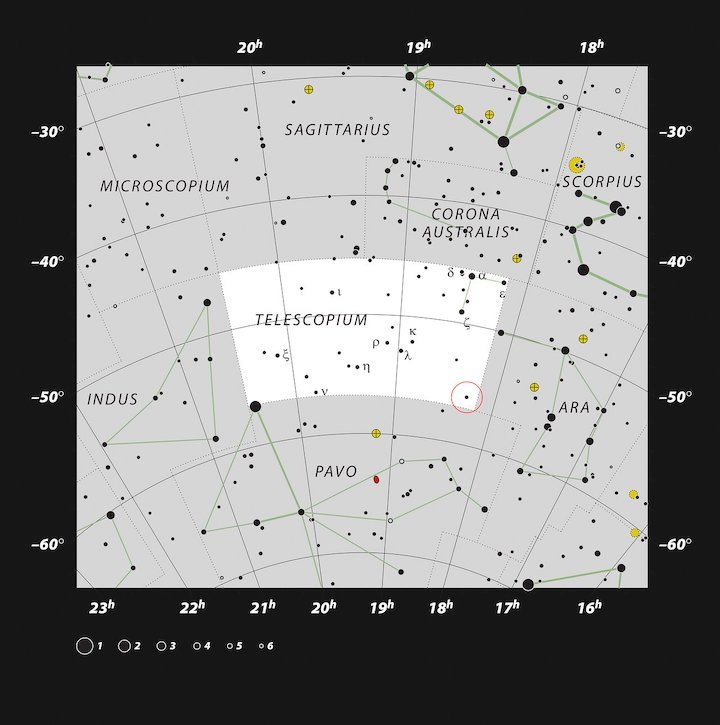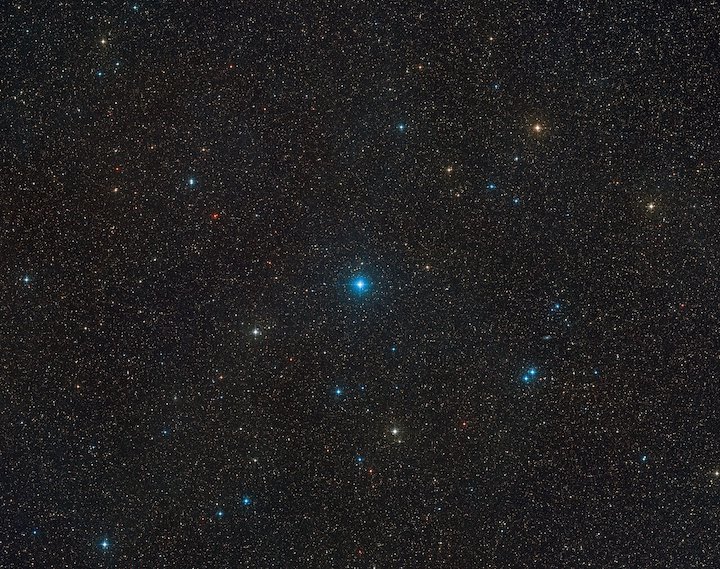7.05.2020
The black hole was found by accident as researchers were tracking two stars.

The closest black hole to Earth's solar system has been discovered by a team of astronomers who say it was hiding in plain sight only about 1,011 light-years away.
The black hole -- which NASA defines as a great amount of matter packed into a very small area with a gravitational field so strong that nothing, not even light, can escape -- was discovered in a star system called HR 6819 and is about four times the mass of the sun, according to the findings published on Wednesday in the scientific journal Astronomy & Astrophysics.
"We were totally surprised when we realized that this is the first stellar system with a black hole that can be seen with the unaided eye," Petr Hadrava, co-author of the study and emeritus scientist at the Academy of Sciences of the Czech Republic in Prague, said in a statement.
Scientists stumbled upon the out-of-this-world discovery in the Telescopium constellation while tracking two stars orbiting each other just outside the gravitational pull of the black hole, with the help of a super telescope at the European Southern Observatory's La Silla Observatory in Chile.
The HR 6819 black hole is similar in size to ones found in the Milky Way, which is about 25 million light-years from Earth's solar system in the constellation Canes Venatici, according to researchers. Based on the cosmic distance scale, one light-year equals about 6 trillion miles.
"Usually when you have a black hole with a star around it, we can't actually see the star go around the black hole," study co-author Marianne Heida, a postdoctoral fellow at the European Southern Observatory, told National Geographic. "This one is so close by, we should be able to to see the motion ... and that means you could get a much better handle on the black hole's mass, if it all works out."
Other stargazers were buzzing about the major discovery that could give astronomers their best chance at unlocking the mysteries of the galactic phenomenon.
"It seems like it's been hiding in plain sight," astronomer Kareem El-Badry, a Ph.D. student at the University of California, Berkeley, who wasn't involved with the study, told National Geographic. "It's a bright enough star [system] that people have been studying it since the 80s, but it seems like it's had some surprises."
While most black holes are invisible, scientist managed to capture the first image of one last year. The never-before-seen black hole is in a galaxy far, far away called Messier 87. Located near the center of that galaxy, it's about 53 million light-years from Earth.
The image was captured by the Event Horizon Telescope, a network of observatories spanning the globe.
Quelle: abcNews
+++
You can 'see' the closest known black hole to Earth with the naked eye
There is a black hole in our backyard. Astronomers have found the closest black hole yet at just 1000 light years from Earth, close enough to see the stars that orbit it without a telescope.
Marianne Heida at the European Southern Observatory in Germany, and her colleagues spotted this black hole completely by accident. It is part of a system called HR 6819 that also contains two stars. The team was looking for pairs of stars in which one was a type that rotates so quickly it flings off material from its equator, creating a kind of ring from its own plasma.
They found HR 6819, which has one of those plus one normal star, but the normal star appeared to be orbiting an empty spot of space once every 40 days. That turned out to be a black hole at least four times as massive as the sun, invisible because it is not actively devouring any material.
“There must be a bunch of them closer by that we haven’t found yet, but this is the closest that we know,” says Heida. “Based on the number of stars in the Milky Way, we expect that there are about 100 million of these small black holes, and we’ve only found less than 100 of them.” If black holes were spread evenly throughout the galaxy, the closest should be just 30 to 40 light years away, she says.
Not only is this the closest black hole we’ve found, it’s also the first one that’s been spotted in a triple system and one of very few inactive black holes that have been spotted. Most black holes are probably practically invisible like this one, so finding more like this can help us get a handle on exactly how many black holes there are in our galaxy.
Luckily, this black hole is far enough away that we don’t need to worry about it. “Earth is not in any danger,” says Heida. “Given that there are two stars that are much closer than we are, and they are not falling in, we won’t fall in.”
But if you want to keep an eye on it, the system can be seen in the sky in the southern hemisphere, in the constellation Telescopium.
Quelle: NewScientist
----
Update: 8.05.2020
.
ESO Instrument Finds Closest Black Hole to Earth
Invisible object has two companion stars visible to the naked eye

A team of astronomers from the European Southern Observatory (ESO) and other institutes has discovered a black hole lying just 1000 light-years from Earth. The black hole is closer to our Solar System than any other found to date and forms part of a triple system that can be seen with the naked eye. The team found evidence for the invisible object by tracking its two companion stars using the MPG/ESO 2.2-metre telescope at ESO’s La Silla Observatory in Chile. They say this system could just be the tip of the iceberg, as many more similar black holes could be found in the future.
"We were totally surprised when we realised that this is the first stellar system with a black hole that can be seen with the unaided eye,” says Petr Hadrava, Emeritus Scientist at the Academy of Sciences of the Czech Republic in Prague and co-author of the research. Located in the constellation of Telescopium, the system is so close to us that its stars can be viewed from the southern hemisphere on a dark, clear night without binoculars or a telescope. “This system contains the nearest black hole to Earth that we know of,” says ESO scientist Thomas Rivinius, who led the study published today in Astronomy & Astrophysics.
The team originally observed the system, called HR 6819, as part of a study of double-star systems. However, as they analysed their observations, they were stunned when they revealed a third, previously undiscovered body in HR 6819: ablack hole. The observations with the FEROS spectrograph on the MPG/ESO 2.2-metre telescope at La Silla showed that one of the two visible stars orbits an unseen object every 40 days, while the second star is at a large distance from this inner pair.
Dietrich Baade, Emeritus Astronomer at ESO in Garching and co-author of the study, says: “The observations needed to determine the period of 40 days had to be spread over several months. This was only possible thanks to ESO’s pioneering service-observing scheme under which observations are made by ESO staff on behalf of the scientists needing them.”
The hidden black hole in HR 6819 is one of the very first stellar-mass black holes found that do not interact violently with their environment and, therefore, appear truly black. But the team could spot its presence and calculate its mass by studying the orbit of the star in the inner pair. “An invisible object with a mass at least 4 times that of the Sun can only be a black hole,” concludes Rivinius, who is based in Chile.
Astronomers have spotted only a couple of dozen black holes in our galaxy to date, nearly all of which strongly interact with their environment and make their presence known by releasing powerful X-rays in this interaction. But scientists estimate that, over the Milky Way’s lifetime, many more stars collapsed into black holes as they ended their lives. The discovery of a silent, invisible black hole in HR 6819 provides clues about where the many hidden black holes in the Milky Way might be. “There must be hundreds of millions of black holes out there, but we know about only very few. Knowing what to look for should put us in a better position to find them,” says Rivinius. Baade adds that finding a black hole in a triple system so close by indicates that we are seeing just “the tip of an exciting iceberg.”
Already, astronomers believe their discovery could shine some light on a second system. “We realised that another system, called LB-1, may also be such a triple, though we'd need more observations to say for sure,” says Marianne Heida, a postdoctoral fellow at ESO and co-author of the paper. "LB-1 is a bit further away from Earth but still pretty close in astronomical terms, so that means that probably many more of these systems exist. By finding and studying them we can learn a lot about the formation and evolution of those rare stars that begin their lives with more than about 8 times the mass of the Sun and end them in a supernova explosion that leaves behind a black hole."
The discoveries of these triple systems with an inner pair and a distant star could also provide clues about the violent cosmic mergers that release gravitational waves powerful enough to be detected on Earth. Some astronomers believe that the mergers can happen in systems with a similar configuration to HR 6819 or LB-1, but where the inner pair is made up of two black holes or of a black hole and a neutron star. The distant outer object can gravitationally impact the inner pair in such a way that it triggers a merger and the release of gravitational waves. Although HR 6819 and LB-1 have only one black hole and no neutron stars, these systems could help scientists understand how stellar collisions can happen in triple star systems.
More information
This research was presented in the paper “A naked-eye triple system with a nonaccreting black hole in the inner binary”, published today in Astronomy & Astrophysics (doi: 10.1051/0004-6361/202038020).
+++
Location of the HR 6819 in the constellation of Telescopium

This chart shows the location of the HR 6819 triple system, which includes the closest black hole to Earth, in the constellation of Telescopium. This map shows most of the stars visible to the unaided eye under good conditions and the system itself is marked with a red circle. While the black hole is invisible, the two stars in HR 6819 can be viewed from the southern hemisphere on a dark, clear night without binoculars or a telescope.
+++
Wide-field view of the region of the sky where HR 6819 is located

This wide-field view shows the region of the sky, in the constellation of Telescopium, where HR 6819 can be found, a triple system consisting of two stars and the closest black hole to Earth ever found. This view was created from images forming part of the Digitized Sky Survey 2. While the black hole is invisible, the two stars in HR 6819 can be viewed from the southern hemisphere on a dark, clear night without binoculars or a telescope.
Quelle: ESO
